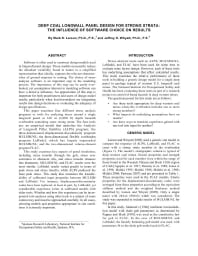Mining Publication: Deep Coal Longwall Panel Design for Strong Strata: The Influence of Software Choice on Results
Original creation date: June 2009
Authors: MK Larson, JK Whyatt
NIOSHTIC2 Number: 20035533
Proceedings of the International Workshop on Numerical Modeling for Underground Mine Excavation Design. Esterhuizen GS, Mark C, Klemetti TM, Tuchman RJ, eds., Pittsburgh, PA: National Institute for Occupational Safety and Health; IC 9512, 2009 Jun; :75-87
Software is often used to construct design models used in longwall panel design. These models necessarily reduce the abundant variability found in nature to a simplified representation that, ideally, captures the relevant characteristics of ground response to mining. The choice of stress analysis software is an important step in the modeling process. The importance of this step can be easily overlooked, yet assumptions inherent in modeling software can have a decisive influence. An appreciation of this step is important for both practitioners and users of design model results, particularly when decision-makers are integrating results into design decisions or evaluating the adequacy of design specifications. This paper examines four different stress analysis programs or tools for analyzing stress around a single longwall panel at 610 m (2,000 ft) depth beneath overburden containing some strong strata. The four tools are: an empirical model that underlies the Analysis of Longwall Pillar Stability (ALPS) program; the three-dimensional displacement-discontinuity program MULSIM/NL; the three-dimensional flexible overburden program LaModel, which has largely superseded MULSIM/NL; and the two-dimensional volume-element program FLAC. This study examines key aspects of panel simulation, including stress transfer through the gob, stress concentration in abutment ribs, and stress transfer distance into abutments. MULSIM/NL and FLAC results were the most similar. LaModel results varied greatly in terms of peak stress and stress transfer, while ALPS produced the least peak stress. This study also examines the transferability of calibrated input properties between MULSIM and LaModel. For instance, displacement-discontinuity codes have been replaced, at least in part, by LaModel, yet considerable experience exists in calibrated models with older tools. Whether and how this experience can be incorporated into analyses using other tools is a subject of some controversy and must be approached carefully. In all cases, selecting models and properties appropriate to site conditions is extremely important.

NIOSHTIC2 Number: 20035533
Proceedings of the International Workshop on Numerical Modeling for Underground Mine Excavation Design. Esterhuizen GS, Mark C, Klemetti TM, Tuchman RJ, eds., Pittsburgh, PA: National Institute for Occupational Safety and Health; IC 9512, 2009 Jun; :75-87
- Analysis and Prediction of Longwall Methane Emissions: A Case Study in the Pocahontas No. 3 Coalbed, VA
- Calculation of Vertical Stress Exerted by Topographic Features
- Calibration and Verification of Longwall Stress Models
- Comparison of Ore Pass Computer Simulations for Designs Against Dynamic Load
- Critical Review of Numerical Stress Analysis Tools for Deep Coal Longwall Panels Under Strong Strata
- Development and Application of Reservoir Models for the Evaluation and Optimization of Longwall Methane Control Systems
- Development of Multiple Regression Functions for Performance Prediction of Gob Gas Ventholes for Sealed and Active Longwall Mines
- Modernization and Further Development of the NIOSH Mine Emergency Response Training System (MERITS), Phase 1
- Technology News 505 - NIOSH Releases New Coal Mine Roof Rating Software
- Use of Strain-Gauged Rock Bolts to Measure Rock Mass Strain During Drift Development